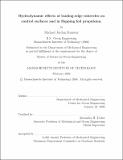Hydrodynamic effects of leading-edge tubercles on control surfaces and in flapping foil propulsion
Author(s)
Stanway, Michael Jordan
DownloadFull printable version (6.007Mb)
Other Contributors
Massachusetts Institute of Technology. Dept. of Mechanical Engineering.
Advisor
Alexandra H. Techet.
Terms of use
Metadata
Show full item recordAbstract
This thesis investigates the hydrodynamic effects of biologically-inspired leading-edge tubercles. Two complementary studies examine the performance of three-dimensional hydrofoils based on the pectoral flippers of the Humpback whale (novangilae megaptera). The first study uses a static foil, with application to conventional control surfaces--such as rudders or dive planes--found on marine vehicles. The second study uses a dynamic foil, with application to flapping foil propulsion. The lift and drag characteristics of foils with and without tubercles are compared using force measurements from experiments conducted in a water tunnel at four Reynolds numbers between 4.4 x 104 and 1.2 x 105. Results from these experiments indicate the foils stall from the trailing edge in the range of Reynolds numbers tested. Stall was delayed on the foil with tubercles; maximum lift was reduced in all cases but the highest Re. PIV flow visualization at Re = 8.9 x 104 showed flow separation at the trailing edge of both foils as attack angle was increased, confirming that the foils were in trailing edge stall. Surface normal vorticity in ensemble averaged flow fields showed distinct pairs of opposite sign vortical structures being generated by the tubercles, providing some insight into the fluid dynamic mechanism that leads to changes in the performance of a foil with tubercles. Tubercles were used on a flapping foil for the first time. Mean thrust coefficient, CT , power coefficient, CP , and efficiency, n, were measured over a wide parametric space. The maximum thrust coefficient and efficiency measured using the smooth control foil were CT = 3.511 and n = 0.678. The maxima using the tubercled test foil were CT = 3.366 and n = 0.663. In general, the foil with tubercles performed worse than the control, and this performance deficit grew with increased loading. (cont.) These results suggest that the vortical structures generated by the tubercles interfere with the thrust wake generated by flapping, ultimately degrading performance.
Description
Thesis (S.M.)--Massachusetts Institute of Technology, Dept. of Mechanical Engineering, 2008. This electronic version was submitted by the student author. The certified thesis is available in the Institute Archives and Special Collections. Includes bibliographical references (p. 99-101).
Date issued
2008Department
Massachusetts Institute of Technology. Department of Mechanical EngineeringPublisher
Massachusetts Institute of Technology
Keywords
Mechanical Engineering.